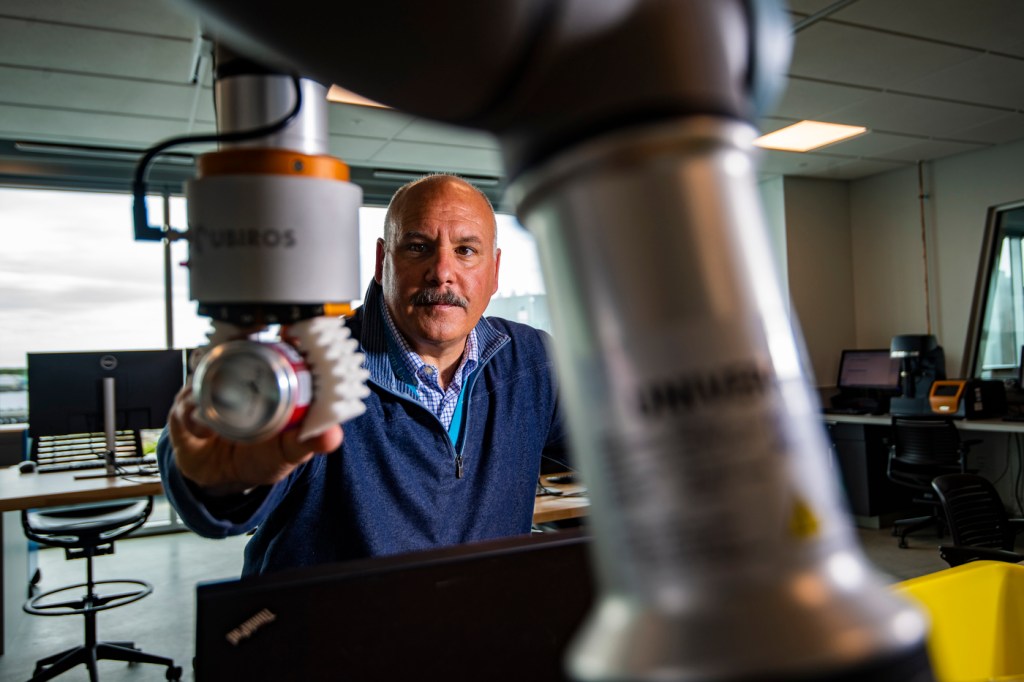How Northeastern’s Roux Institute is using real-time data to bring Industry 4.0 to Maine

Supply-chain shortages have exposed a crucial blind spot in U.S. industry, says Jack Lesko, director of engineering research at Northeastern’s Roux Institute in Portland, Maine. Too many American companies are failing to make use of data that could help them respond to real-time events—and thereby are falling behind their global rivals.
“China, Japan, Singapore and the U.K. have adopted advanced manufacturing in a big way,” Lesko says.
Lesko is a proponent of Industry 4.0—also known as the fourth Industrial Revolution—to build manufacturing resilience, enabling companies to respond to regional and global needs based on real-time data.
“Think about the difference between a Volkswagen Beetle and a Tesla,” Lesko says. “A Volkswagen Beetle had no computers. Everything was manually operated. Now you go to the Tesla: It has all these sensors and it uses information from those sensors to make decisions for you.”
Lesko is an entrepreneur with three decades of design and analytics experience across a variety of fields and services. Since joining the Roux Institute last year, he has been focused recently on bringing Industry 4.0 to Maine companies with optimism that the approach will spread throughout the state and the New England region.
Lesko spoke with News@Northeastern about the agility of the Industry 4.0 approach, the need for companies to be learning organizations, and how data-driven decision-making could help renew manufacturing and supply chain systems in the U.S. His comments have been edited for clarity and brevity.
Which of your real-world experiences helped shape your belief in Industry 4.0?
I’m a mechanical engineer. I spent 10 years working with Rolls Royce and they had a very strong advanced manufacturing program. And I ended up being on the board of a membership organization in the aerospace industry looking at technologies in the advanced manufacturing space.
I got here to the Roux Institute and began to look into the issues around using Industry 4.0 to build an agile platform—so that if we get back into a situation like [the COVID-19 pandemic], we’ve got that flexibility of manufacturing and supply chains that is needed.
What prevents companies from transitioning to Industry 4.0?
We have companies saying, “I’m collecting all this data, and I know I need to do something with it. But I don’t know how and where to start.”
Here in Maine I’ve talked to more than 40 companies. They’re collecting data and not doing anything with it; or they’re using it in isolated ways. They’re not really looking across the whole platform and completely leveraging Industry 4.0 for decision-making on the manufacturing floor.
You’re saying that assessments of real-time data—of realizing and then reacting to needs in the marketplace—could lead to a revitalization of U.S. manufacturing?
The United States over the last 30 to 40 years has lost about 30% of its manufacturing capacity. And that’s borne out in the White House 100-day report on supply chains—that we have an inadequate manufacturing base of fundamental things like [computer] chips and APIs (active pharmaceutical ingredients). The active pharmaceutical ingredients and critical materials are from other countries, and we don’t control any of that.
If we’re thinking not just about the manufacturing plant then we can expand our understanding of the system of manufacturing and supply chain together. In the manufacturing plant, we’ll be tying our decisions to the raw material side—how do I know I’m going to get the raw materials I need, and how do I know that it’s going to get to a customer?
Can the data-driven approach be good for workers?
One of the big challenges that these manufacturers have is that they don’t have enough people. They’re having a hard time getting people, so they’re being forced into automation to build more with less.
The reality when you add automation and higher-level capabilities is that workers are better engaged and companies are experiencing retention and actually hiring more people.
How important is the point of view of company leaders?
Is this a learning organization? You’ve got to recognize that culture is going to play a major role in the adoption to advanced manufacturing and Industry 4.0.
One of the things that we’ve been putting together is the Industry 4.0 readiness assessment, which helps the company decide how they may make an initial investment or a series of investments to help them with this digital and data-driven transformation.
Is it a simple choice: Either make this transition or be left behind?
You’re not going to be able to compete internationally when other companies are doing this. A delayed decision now is going to cause exponential setback and competitive disadvantage later.
For media inquiries, please contact media@northeastern.edu.






